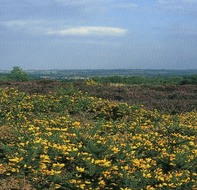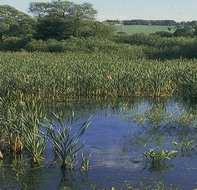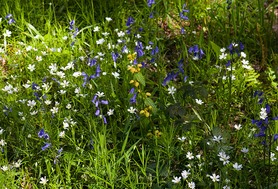

Biodiversity
Action
Plan

Standing Water*. The local priority habitat includes all standing water that is capable of supporting biodiversity and populations of key species. It includes ponds and both nutrient-poor and -rich water bodies.
Standing water in Barnsley, at least 404 ha in area, ranges from moorland reservoirs such as Winscar and lowland reservoirs like Worsbrough, to small lakes and ponds, subsidence flashes, remnants of canals, drainage ditches and areas of open water within flooded wetlands.
Blanket Bog is an important priority habitat based on wet peat, amounting to 2164 ha on the Barnsley upland moors in the Dark Peak, although much of the habitat is not in favourable condition.
Local Priority Habitats
Running Water, rivers and streams*. The local priority habitat includes all rivers and streams capable of supporting biodiversity and in particular river sections or streams in Barnsley with priority species present.
National priority river habitat in Barnsley includes headwaters to the Don and Little Don, shingle river sections of the Don and Cawthorne Dyke, and the Dearne because of the number of priority species it supports.
Lowland Heathland is rather scarce (7 ha) and fragmented in Barnsley, found on the edges of slopes of sandstone hills, on former commons, and on former pit-stacks.
Arable Field Margins*: field margins designed to benefit key farmland species in arable areas. In-field measures like skylark plots and beetle banks are included in the local priority habitat.
Open Mosaic on Previously Developed Land* is a national priority habitat found in Barnsley on sites where soils have been modified and one or more early successional communities have become established in a mosaic with bare substrate.
Other specialised habitats may be found where there is industrial spoil or limestone ballast affecting the soil: the types of vegetation found may be very different to those found elsewhere in Barnsley.
Built-up areas and gardens, buildings and their grounds, allotments, verges and urban open spaces can provide a very significant resource for many common and vulnerable species. Their value should not be ignored. For this reason a section has been added to the local biodiversity plan with descriptions of how to promote biodiversity in these settings.
Most wildlife species need certain habitats to support them. Different habitats support very different communities of plants and animals. Their differences stem from the underlying rocks and soils, the prevailing climate and how wet and cold it tends to be, the interactions between plants and animals, and not least the interventions of man.
Careful management is needed to sustain the special characteristics that are of value for wildlife. Many habitats of particular value for plants and animals have been sustained by activities such as managed grazing, late season mowing, wetland maintenance and woodland management.
The local priority habitats are in the main the same as those identified nationally as threatened and requiring conservation action. Their titles are given in the column on the right. In some cases the definition of the local priority habitat is wider than the national ‘equivalent’, indicated by a * next to the title.
Two habitats have been included in the local list that are not priorities for conservation in the usual sense but can be managed to benefit biodiversity. These are amenity grassland and built environment and gardens, school grounds & other urban green spaces.
Scrub is a third habitat included in the local priority list which is not identified nationally. It can be a significant habitat for wildlife species. Other habitat features for example field edges, ditches, walls, quarries and rock outcrops can also be important at times.
The best priority habitat sites should be protected and conserved, others should be retained if viable and their value for wildlife improved. As well as having objectives for priority habitat site an overall objective should be to secure the connection of priority habitat sites in a network through the landscape which allows wildlife to thrive. [See Habitat networks]
The Local Priority Habitats can be found below with links to information on individual habitats. Further minor amendments may be made.


Local priority habitats.
A number of habitats in Barnsley have been identified as requiring protection, restoration and positive conservation management. These priority habitats have special characteristics that support wildlife: they have distinctive plant communities and provide food supplies, shelter and sites for nesting and roosting for a range of wildlife species.
Threatened and requiring protection, 56 ‘habitats of principal importance for conservation ’ have been published in a list for England under Section 41 of the NERC Act 2006.
This S41 list includes all the habitats identified as priority habitats in the UK BAP
They are regarded as priorities in the Post-2010 Biodiversity Framework. for England.
National Planning Policy states: ‘To protect and enhance biodiversity… policies should promote the conservation, restoration and enhancement of priority habitats NPPF 179b
In Barnsley we have at least 20 of these “UK BAP” or national priority habitats:
- Mixed deciduous woodland
- Upland oakwood
- Wet woodland
- Woodpasture and parkland (inc. veteran trees)*
- Traditional orchards
- Lowland dry acid grassland
- Lowland meadow/neutral grassland
- Floodplain grazing marsh
- Rush pasture
- Hedgerows
- Arable field margins*
- Upland heath
- Lowland heath
- Blanket Bog
- Reedbeds *
- Lowland fens
- Upland flushes, fens and swamps
- Rivers (running water)*
- Ponds (standing water)*
- Eutrophic standing water
- Open mosaic habitats on previously developed land*
* indicates local priority habitat wider than national definition.
Other habitats of potential value included in our local list:
- scrub
- amenity grassland and verges
- built environment and gardens, school grounds & other urban green spaces.
Upland Oakwood: the woodland priority habitat in the Dark Peak with only remnants in Barnsley. The character of this priority habitat should be born in mind for any planting of trees on Barnsley moors and cloughs.
Mixed Deciduous Woodland: the main woodland priority habitat in Barnsley, made up of mixed oak-birch and ash woodland, amounting to 2259 ha, much of which is ancient woodland or planted on ancient woodland.
Wet Woodland. Willow carr is a notable form in Barnsley of the wet woodland priority habitat, the natural cover for wet soils. Other forms of wet woodland in Barnsley have alder and ash as dominant trees.
Parkland and Wood Pasture (610 ha). This habitat of trees within grazed grass is mainly found in historic parkland in Barnsley. Veteran trees in parks or elsewhere are included in this priority habitat.
Traditional Orchards, at least 6 ha scattered across Barnsley, are associated with historic country house estates and older farmsteads, with small community orchards more recently created,
Scrub. Although not a national priority habitat, Scrub can support a range of wildlife species and is of value for biodiversity. It is found on unmanaged open space, along watercourses, railway tracks etc in Barnsley.
Hedgerow priority habitat has 80% or more of at least one native woody species of tree or shrub; the best being ancient &/or ‘species rich' (at least four different native tree or shrub species).
Lowland Dry Acid Grassland (184 ha): found as grazing pasture, in some parklands, and on slopes and other areas where there are nutrient poor soils. Field corners, verges and banks sometimes retain this habitat.
Neutral Grassland or Lowland Meadow (64 ha) is found on richer shale and alluvial soils in lowland pastures and meadows. Recreational sites, churchyards, verges, etc may retain this species-rich grassland.
Floodplain Grazing Marsh (66 ha), this combination of wet often seasonally flooded grassland and standing water, is found on river floodplain sites in the Dearne Valley and classed here as a wetland habitat.
See wetlands below
Rush Pasture. Pockets are found in poorly drained, acidic soils, across the broad swathe of land between Ingbirchworth and Langsett. It may also be classed as a wetland (fen, marsh and swamp) habitat.
Amenity Grasslands and Verges, although not a priority habitat in the usual sense, can also be managed to promote biodiversity and are included in this list for that reason.
Continued below …
All unimproved or semi-improved grassland has value and is important in Barnsley for biodiversity.
Upland Heathland covers extensive areas (296 ha) of the slopes of moors in the west of Barnsley above enclosed pastures and the 300 metre contour, although much of the habitat is not in favourable condition.
Reedbed*. Some priority species like bittern depend on sizeable individual or groups of reedbeds. There are at least 12 ha of reedbed in the Dearne valley where bittern have begun to breed.
Floodplain Grazing Marsh (66 ha). This combination of wet often seasonally flooded grassland and standing water, is found on river floodplain sites in the Dearne Valley and is important for wetland birds.
Lowland Fen. This priority habitat is scarce in Barnsley with remnants amounting to 8 ha to be found in the Dearne Valley. Fen vegetation is more often found.
Upland Flushes, Fens and Swamps. This priority habitat amounts to 31 ha found on the moors and upland fringes in the west of Barnsley.
Included in above
Included in above
NB
Local Priority Habitat sections subject to minor amendments.

Local Priority Habitats